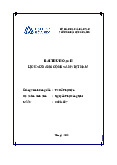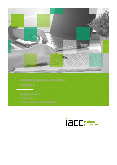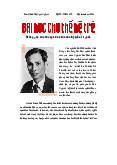



















Preview text:
ĐỀ CƯƠNG ÔN TẬP CUỐI KỲ LOGISTICS I.
INTRODUCTION TO LOGISTICS (Uyên Trần )
1. This activity involves the use of different modes of transportation......
● Transformation of natural resources
● Processing of raw materials
● Delivering the finished products
● Storage of raw materials and finished goods
2.Which activity involves the use of warehousing?
● Transformation of natural resources
● Storage of work in progress and finished goods
● Delivering of the finished goods
● Movement of natural resources
3.The activity which involves changing items from it's original state.....
● Movement and storage of natural resources
● Storage of work-in progress and finished goods
● Delivering the finished product
● Transformation of natural resources
4. Transportation is the ........ of humans, animals and goods from one location to another ● distribution ● activity ● movement ● planning
5.The meaning of transportation is derived demand
● using transport because of its direct benefits
● using transport because wants to move
● using transport not because of its direct benefits, but because want to access another services/needs 6.Tronton is one of ... ● land transport mode ● rail transport mode ● air transport mode
● sea transport model is correct 7. Freighter is one of ... ● land transport mode ● rail transport mode ● air transport mode ● sea transport mode
8.According to Djoko Setijowarno dan Frazila (2001), each of transport modes
has different characteristics in term of ... , except. ● speed ● availability of service ● capability ● variability
9. One of advantage of air transportation is ... ● Cheap
● suitable for valuable items ● noise pollution ● longer delivery time
10. One of advantage of sea transportation is ● Cheap
● suitable for valuable items ● flexible route ● speed
11. Main characteristics of goods in air transportation are ● cheap and large
● valuable or perishable goods and urgent ● Liquid and easy to pack ● high tech and easy to pack
12. The advantages of land transportation is ● flexible ● door to door
● possible to change the destination in the middle of trip ● all is correct
13. Division of labor by Adam Smith drives ..... ● manufacture ● production ● nation trade ● high quality
14.Logistics is part of supply chain. ● True ● False
15. Main key in Logistics are ... ● technology and cost ● quality and technology ● price and quantity ● service and cost
16.Logistics activity, except ... ● inventory management ● product design ● demand forecasting ● location selection
17.operational objective in logistics is ...
● the right number and quality of inventory
● procurement activity can be carried efficiently
● maintain and support the efficiency and effectiveness to achieve organization goals ● selling many product
18.security objective in logistics is ...
● the right number and quality of inventory
● procurement activity can be carried efficiently
● maintain and support the efficiency and effectiveness to achieve organization goals ● selling many product
19. financial objective in logistics is ...
● the right number and quality of inventory
● procurement activity can be carried efficiently
● maintain and support the efficiency and effectiveness to achieve organization goals ● selling many product
20. the general purpose of logistics is to focus on achieving organizational
goals in an effective and efficient way. ● true ● false
21. In logistics, the raw material is one of the consumer goods ● true ● false
22. In logistics, production goods can be directly used by consumers to meet their needs ● true ● false
23. In the supply chain network, the role of transportation is to connect one point to another point ● true ● false II.
INTRODUCTION TO SUPPLY CHAIN MANAGEMENT (Phụng)
1. The initial stage of the supply chain process is the _____________. A. Sourcing Stage B. Organizing Stage C. Planning stage D. Directing Stage
2. The term supply chain management was first coined by ______. A. Frankel & Paulraj B. Peter Drucker C. Keith Oliver D. Philip Kotler
3. In supply chain management, after planning, the next step involves ______________. A. Developing
B. Building a strong relationship with suppliers C. Sourcing D. All of the above
4. In Supply Chain Management, ATP stands for _________. A. Acquire Track & Perform B. Available To Promise C. Active Transport Protocol D. Access To Point
5. The purpose of supply chain management is to_______.
A. increase the production level
B. manage and integrate supply and demand management
C. enhance the quality of a product and services
D. provide satisfaction to the customer
6. ________is the primary activity of supply chain management. A. Demand Management
B. Supply Planning i.e matching assets with demand C. Analytics Workbench D. All of the above
7. Another important purpose of supply chain management is to ___________.
A. make inventory readily available
B. delight customers and suppliers
C. create warehouses at various locations
D. to promote supply chain process
8. ________is mainly deals with all activities associated with the flow and
transformation and information of goods from the stage of raw material to the end user i.e. consumption. A. Production Line B. Supply Chain C. Inventory management D. Marketing Channel
9. In supply chain management, Inspection, scrap and repair are examples of ________. A. Societal Costs B. External Costs C. Costs of dissatisfaction D. Internal Costs 10.
____________ is a Japanese term meaning continuous improvement. A. JIT B. Kaizen C. TQM D. Taguchi Map 11.EOQ stands for ____
A. Electronic Obtained quantity B. Electronic Ordered Quantity C. Economic Order Quality D. Economic Order Quantity 12.
Organizations or companies manage their supply chains through _______. A. Transportation modes B. The internet C. Information D. Skilled Operators 13.
The concept and philosophy of supply chain management evolved or emerged in _______ A. The 1960s B. The 1970s C. The 1980s D. The 1990s 14.
Full form of MRP in operations and SCM is ___________ A. Material Return Process
B. Material Requirement Planning
C. Machinery Repairing Planning D. Material Retention Planning 15.
The concept of supply chain management originated in ________________ discipline. A. Production Management B. Logistics Management C. Marketing Management D. Operations Management 16.
In operations & supply chain management, Kaizen is a Japanese term meaning __________. A. Change for the better B. Continuous Performance C. Top-level quality D. Use of Kaizala app 17.
According to Frankel, Bolumole, Eltantawy, Paulraj& Gundlach, (2008),
these are the four functions identified as foundational – operations, logistics, supply management, __________. A. Marketing B. Production C. Materials D. Procurement 18.
Positive long-term relationships between supply chain participants refer to ______ A. Supply chain management B. Partnerships C. Co-operations D. Co-alliances 19.
Supply chain management is the management of the ____________. A. Storage Raw Materials B. Flow of goods and services C. Fulfillment of order D. Satisfaction of customer 20.
______ is not a part of flows involved in supply chain management. A. Information Flow B. Title Flow C. Physical Flow D. Virtual Flow 21.
___________ involve the transformation, movement, and storage of goods and materials. A. Virtual Flow B. Physical Flow C. Title Flow D. Information Flow 22.
A supply chain is a sequence of firms that perform activities required to ______
A. to facilitate wholesalers inventory selections
B. to create synergy in their training programs
C. to find products that are similar
D. to create and deliver goods to consumers 23.
A U.S. equipment manufacturer finds a less expensive source of supply in China
for steel forgings currently purchased from a United State's supplier. The
manufacturer switches from the U.S. to the Chinese forging supplier. This is an
example of which of the following important trends in operations and supply chain management? A. Electronic Commerce
B. Increasing Competition and Globalization
C. Radio Frequency Identification (RFID) D. Relationship Management
24.Which of these statements about the transformation process is best?
A. The availability of inputs usually has little impact on the operations function.
B. Inputs to operations usually come from only one place and take one form.
C. Operations are highly dependent on the quality of inputs.
D. Operations activities are usually independent of other business activities such as engineering and marketing.
25.Which of these is NOT a flow that moves up and down the supply chain? A. Procedural B. Monetary C. Information D. Physical
26."The planning, scheduling, and control of the activities that transform inputs into
finished goods and services" is the definition of ______ A. Service operations. B. Operations management. C. Supply chain. D. Operations function.
27. "A network of manufacturers and service providers that work together to convert
and move goods from the raw materials stage through to the end user" is the definition of______ A. Supply chain. B. Operations management. C. Service operations. D. Operations function.
28.Which of these is an output to a single organization's transformation process? A. Fulfilled needs B. Information C. Intangible needs D. Materials
29.A retailer cooperates with a manufacturer by coordinating promotional activities
(items they plan to put on sale and advertise heavily) with the manufacturer to
assist the manufacturer plan production and inventory. This is an example of which
of the following important trends in operations and supply chain management?
A.Radio Frequency Identification (RFID)
B. Increasing Competition and Globalization C. Relationship Management D. Electronic Commerce
30.The use of information technology to automate business transactions is known as______
A. Management Information Systems.
B. Computer Integrated Manufacturing. C. E-Commerce. D. POS.
31.A decade ago, most music was sold as physical CDs in music stores. Companies,
such as Apple, sell music over the internet. In this example, by effectively utilizing
information technology to automate this business transaction, Apple exhibits which
of the following important trends in supply chain management? A. Electronic Commerce B. Relationship Management
C. Increasing Competition and Globalization
D. Radio Frequency Identification (RFID)
32.The text indicates that which of the following is perhaps the most difficult of all the
activities that operations and supply chain personnel perform? A. Sourcing B. Globalizing C. Relationship Management D. Electric Commerce
33.The supply chain function works with marketing and engineering to identify and
qualify suppliers of goods and services as well as manage on-going supplier
relationships. This supply chain activity is ______ A. Logistics B. Purchasing C. Capacity Planning D. Forecasting
34.The supply chain function works with finance and accounting on determining
capital investments in manufacturing plants and resource levels, such as
workforce. This supply chain activity is______ A. Purchasing B. Capacity Planning C. Forecasting D. Logistics
35.The supply chain function works with marketing to develop planning numbers, such
as customer demand and availability of supply, which are needed for effective
decision making. This supply chain activity is _____ A. Purchasing B. Logistics C. Forecasting D. Capacity Planning
36.The supply chain function works with marketing to manage the movement of
physical goods throughout the supply chain. This supply chain activity is A. Capacity Planning B. Purchasing C. Logistics D. Forecasting
37.Which of these operations and supply chain management career paths works
closely with manufacturing, marketing, and purchasing to create timely,
cost-effective import/export supply chains? A. Sourcing Manager B. Analyst C. Logistics
D. International Logistics Manager
38.It was intense global competition that led manufacturers to adopt Supply Chain
Management (SCM) and other practices such as Just-in-Time (JIT): TRUE
39.Strategic partnerships are seen as one of the foundations of supply chain management: TRUE



